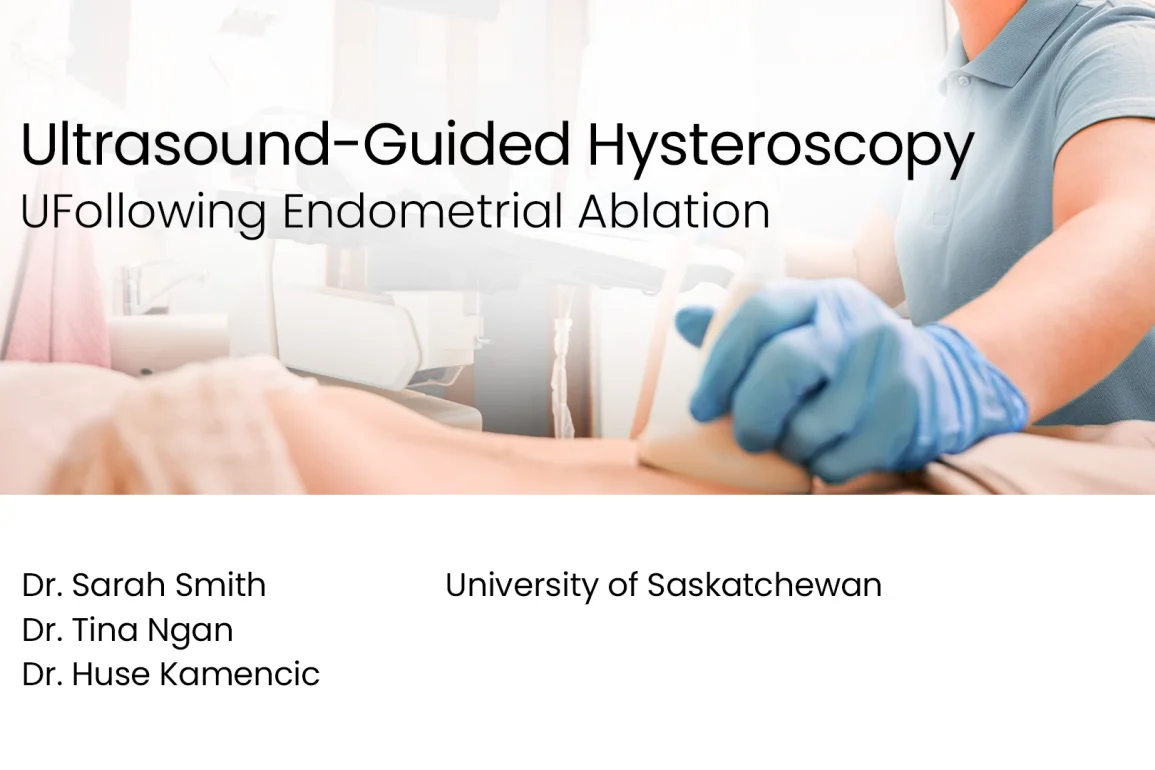Table of Contents
- Procedure Summary
- Authors
- Youtube Video
- What is Ultrasound-Guided Hysteroscopy Following Endometrial Ablation?
- What are the Risks of Ultrasound-Guided Hysteroscopy Following Endometrial Ablation?
- Video Transcript
Video Description
This video abstract demonstrates simultaneous use of pelvic ultrasound and hysteroscopy to access an ablated endometrial cavity.
Endometrial ablation is commonly used to treat abnormal uterine bleeding. It can cause cervical stenosis and adhesions inside the endometrial cavity creating future challenges in accessing the cavity. Failure of endometrial sampling following endometrial ablation is found to be 23 to 26%.
This video demonstrates that ultrasound-guided hysteroscopy on a scarred and distorted endometrial cavity is safe and cost efficient. It facilitates access into the uterine cavity and prevents false passage and uterine perforation.
Presented By
Affiliations
University of Saskatchewan
Watch on YouTube
Click here to watch this video on YouTube.
What is Ultrasound-Guided Hysteroscopy Following Endometrial Ablation?
Ultrasound-guided hysteroscopy following endometrial ablation is a procedure used to access and evaluate the endometrial cavity that has been distorted by previous ablation treatment. This technique involves the simultaneous use of pelvic ultrasound and hysteroscopy to navigate adhesions and scarring within the uterus. The ultrasound provides real-time guidance to the hysteroscope, ensuring safe entry into the uterine cavity and reducing the risk of complications such as uterine perforation.
The procedure is particularly useful for patients who experience abnormal uterine bleeding or require endometrial sampling after ablation. It allows for better visualization and precise dissection of adhesions, improving the likelihood of successful endometrial sampling and minimizing the need for more invasive surgical interventions.
What are the Risks of Ultrasound-Guided Hysteroscopy Following Endometrial Ablation?
The risks of ultrasound-guided hysteroscopy following endometrial ablation include several potential complications associated with the procedure itself and the underlying condition. Key risks include:
- Uterine Perforation: Despite ultrasound guidance, there is still a risk of creating a hole in the uterine wall, which can lead to injury to surrounding organs such as the bladder or bowel.
- Infection: The introduction of instruments into the uterine cavity can result in an infection, necessitating antibiotic treatment.
- Bleeding: The procedure can cause bleeding, particularly when dense adhesions are dissected. Excessive bleeding may require additional medical intervention.
- Adhesion Recurrence: Even after successful removal of adhesions, there is a risk they may recur, potentially requiring further treatment.
- Fluid Overload: The use of saline or other distension media to expand the uterine cavity can lead to fluid overload or electrolyte imbalances if large volumes are absorbed into the bloodstream.
- Incomplete Procedure: There is a possibility that not all abnormal tissue or adhesions are successfully removed, necessitating additional procedures.
- Pain: Patients may experience pain during and after the procedure, although this is typically managed with analgesics.
- Anesthesia Risks: If sedation or anesthesia is used, there are inherent risks associated with these, including allergic reactions and respiratory issues.
Patients undergoing this procedure should be fully informed of these risks and receive appropriate preoperative and postoperative care to minimize complications and ensure a successful outcome.
Video Transcript: Ultrasound-Guided Hysteroscopy Following Endometrial Ablation
We present to you a video of ultrasound-guided hysteroscopy following endometrial ablation. This video will demonstrate simultaneous use of pelvic ultrasound and hysteroscopy to access an ablated endometrial cavity. Endometrial ablation is commonly used to treat abnormal uterine bleeding. It frequently causes distortion and adhesions of the endometrial cavity and cervical stenosis. As a result, this can create a challenge in accessing the cavity for endometrial sampling and reoperation.
Studies have found an endometrial sampling failure rate following ablation of 23 to 26%. We present a case of a 60-year-old gravida 2, para 2 with post-menopausal bleeding. She has a history of a global endometrial ablation 12 years ago, with benign endometrial biopsy at the time of ablation. She is otherwise healthy and has never had other surgery. Pelvic ultrasound demonstrated an endometrial thickness of 5 mm and no other abnormalities noted.
An office endometrial biopsy was attempted, but was unsuccessful. Ultrasound-guided hysteroscopy with endometrial sampling was then discussed. She provided informed consent and was then booked for the procedure. A 2.9 mm operative hysteroscope with a 30-degree lens was selected. A skilled assistant provided ultrasound guidance during the procedure. Ultrasound was used to delineate the tract of the endometrial cavity to reduce the risk of uterine perforation.
Dilation was not necessary to enter the cervical os. If difficulty with dilation is encountered, a cervical os finder or mini cervical dilators can be helpful for a stenotic cervical os. Normal saline was used as distension media. Hysteroscopic hydro-dissection was utilised to expand the endometrial cavity for better visualisation. The lower uterine segment was found to have dense adhesions. Under ultrasound guidance, gentle blunt dissection was performed using the hysteroscope.
A hysteroscopic grasper was also utilised to gently dissect the adhesions. Once space was created, the hysteroscope was advanced slowly. Good visualisation and slow, subtle dissection are essential. The endometrial cavity, proximal to the ablated tissue, was then entered. Sampling was able to be performed. We present to you a video of ultrasound-guided hysteroscopy following endometrial ablation. We offer these surgical pearls to increase your success at ultrasound-guided hysteroscopy.
A skilled assistant is essential to perform ultrasound for procedure guidance. Cervical stenosis can be overcome with the cervical os finder or mini cervical dilators. Hydro-dissection with the hysteroscope is useful in dissection of adhesions and improves visualisation. Gentle blunt dissection with the hysteroscope or hysteroscopic graspers can be achieved with slow, subtle movements.
Optimal visualisation is essential throughout the procedure to reduce the risk of uterine perforation or false passage creation. In summary, ultrasound-guided hysteroscopy in a scarred and distorted endometrial cavity is safe and cost-efficient. It facilitates access to the uterine cavity and prevents false passage and uterine perforation, particularly in the case of previous endometrial ablation.




